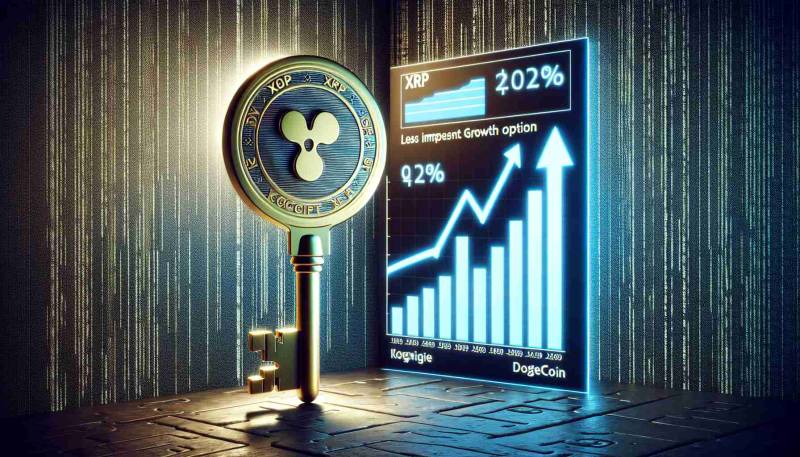 |
|
 |
|
 |
|
 |
|
 |
|
 |
|
 |
|
 |
|
 |
|
 |
|
 |
|
 |
|
 |
|
 |
|
 |
|
Cryptocurrency News Articles
XRP: A Promising Future in the Realm of Digital Currency
Jan 30, 2025 at 04:04 am
XRP, the digital currency created by Ripple Labs, has been making waves in the cryptocurrency space since its inception. Known for its fast transaction speeds
XRP, the digital currency created by Ripple Labs, has been making waves in the cryptocurrency space since its inception. Known for its fast transaction speeds, scalability, and cost-effectiveness, XRP has already proven its worth in the realm of cross-border payments, particularly among financial institutions and businesses. However, the digital asset’s journey is far from over, and its potential to become a mainstream digital currency is ever-growing.
In this article, we will explore the key factors contributing to XRP’s promising future, the opportunities it has to offer, and the steps Ripple can take to fully unlock its potential. As cryptocurrency continues to evolve, XRP is well-positioned to play a significant role in the global economy.
1. The Advantages of XRP: Speed, Cost, and Scalability
One of the core reasons for XRP’s enduring appeal is its technological capabilities. Unlike Bitcoin and Ethereum, XRP’s consensus algorithm (the XRP Ledger) doesn’t rely on energy-intensive mining. This makes XRP far more efficient in terms of transaction speed and cost. XRP transactions are processed in just a few seconds, compared to the longer confirmation times of Bitcoin and Ethereum, and the cost per transaction is a fraction of a penny. This makes XRP ideal for cross-border payments, particularly for businesses looking to cut down on international transaction fees and delays.
As the global economy continues to evolve and demand for faster, cheaper payment systems increases, XRP’s technical advantages will continue to drive its adoption across industries. From facilitating remittances to enabling faster corporate payments, XRP’s speed, scalability, and low fees are key elements that will fuel its growth.
2. Financial Institutions and Cross-Border Payments: XRP’s Core Use Case
XRP’s primary use case has been in the realm of cross-border payments, and it has already gained significant traction with major financial institutions and payment providers. Ripple’s suite of products, including RippleNet and On-Demand Liquidity (ODL), uses XRP to enable near-instant settlement of cross-border transactions.
Ripple has established strong partnerships with major financial institutions like Santander, American Express, and SBI Holdings. These partnerships have showcased XRP’s ability to streamline international payments, eliminating the need for expensive and slow intermediary banks. By offering a faster, more affordable solution to traditional cross-border payment methods, XRP is well-positioned to disrupt the global payments landscape.
As more financial institutions adopt Ripple’s technology, XRP’s liquidity and use cases will expand, helping it establish itself as a leading digital asset in the financial sector.
3. Widespread Consumer Adoption: The Next Frontier for XRP
While XRP has found success within the institutional space, the next major milestone for its growth lies in widespread consumer adoption. To achieve this, Ripple must focus on building a strong infrastructure for retail users. This includes making XRP easily accessible to the average consumer, improving the user experience, and expanding its real-world use cases.
One of the main challenges XRP faces in this regard is accessibility. For many consumers, purchasing and using cryptocurrency can be a complex process, with the need to navigate digital wallets, exchanges, and complex conversion processes. However, Ripple is actively working to simplify this process, making XRP as easy to use as traditional digital currencies like Bitcoin or stablecoins.
Solution: Partnering with Payment Providers and Retailers
To accelerate consumer adoption, Ripple could form partnerships with global payment providers and retailers, allowing consumers to use XRP in everyday transactions. This could include collaborating with payment platforms such as PayPal, Venmo, or Cash App to enable easy XRP purchases and transactions. Additionally, Ripple can work with merchants to integrate XRP as a payment option in their existing systems, offering incentives such as lower transaction fees to encourage businesses to accept the asset.
The key to widespread adoption lies in making XRP as accessible and user-friendly as possible, ensuring that consumers can easily buy, hold, and spend XRP just like they would with fiat currencies.
4. Expanding Use Cases: Beyond Payments
While XRP’s current primary use case is facilitating fast, low-cost cross-border payments, the future of the digital asset holds far greater potential. As the blockchain ecosystem matures, new use cases for XRP are likely to emerge, particularly in areas such as decentralized finance (DeFi), tokenization, and digital identity.
DeFi, which has exploded in popularity in recent years, offers an opportunity for XRP to expand its role in the broader financial ecosystem. By integrating XRP into decentralized lending platforms, liquidity pools, and decentralized exchanges (DEXs), Ripple could make XRP a key asset in the rapidly growing DeFi space. This could also help solve one of XRP’s current challenges—liquidity—by providing new avenues for users to engage with the asset.
Moreover, tokenization of assets (such as real estate, commodities, or even art) is another area where XRP can play a role. By leveraging its fast transaction speeds and low fees, Ripple could enable the seamless transfer and exchange of tokenized assets on a global
Disclaimer:info@kdj.com
The information provided is not trading advice. kdj.com does not assume any responsibility for any investments made based on the information provided in this article. Cryptocurrencies are highly volatile and it is highly recommended that you invest with caution after thorough research!
If you believe that the content used on this website infringes your copyright, please contact us immediately (info@kdj.com) and we will delete it promptly.
-

-

- Bitcoin (BTC) Options Volumes Explode 125% in One Month, Signaling a Market Maturation
- Feb 08, 2025 at 02:06 am
- As traditional end-of-reign predictions for Bitcoin were still circulating, the queen of crypto responded with a stunning performance: a 125% explosion in options volumes in just one month.
-

-

-

-

- Mutuum Finance (MUTM) Emerges as a Promising DeFi Project, Drawing Comparisons to Ethereum (ETH)
- Feb 08, 2025 at 02:06 am
- Mutuum Finance (MUTM) has quickly entered the spotlight as a cryptocurrency that industry observers believe could follow in the footsteps of Ethereum (ETH) in terms of substantial growth potential. With a presale offering at its lowest price and a roadmap featuring a decentralized lending and borrowing platform, Mutuum Finance is attracting both newcomers and experienced investors.
-

-

-

- Maximize Your Crypto Investment: Discover the Power of XRP and Avoid Pitfalls!
- Feb 08, 2025 at 01:56 am
- Investing in cryptocurrency can feel like a thrilling rollercoaster ride, especially with just $1,500 in hand. With countless options clamoring for attention, it's crucial to choose wisely and avoid the pitfalls that can lead to devastating losses.

























































